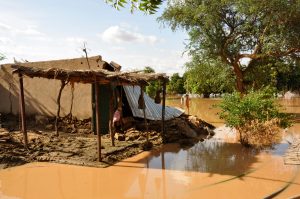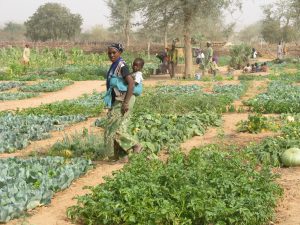By Kayleigh Redmond
Every year, Niger experiences heavy rainfalls that often lead to high surges in local water levels. Last August, at least 45 people were killed and over 226,000 were displaced when torrential rains caused the Niger River to flood. In Niamey, Niger’s capital, entire neighborhoods were submerged. In addition to homes, more than 22,000 acres of farmland were destroyed, leaving many to face the issue of food insecurity. Unfortunately, climate change is a leading cause of these increased downpours, and as it continues to be a prevailing force in the world, Niger will not be safe from this level of impact.

Source: Oxfam International
Climate change is not only predicted to bring increased flooding to Niger, but also excessive droughts, sandstorms, and forest fires. Nearly 43 percent of Niger’s GDP comes from agriculture, forestry, and livestock sectors, and 80 percent of the country’s workforce is involved in these industries. Frequent unpredictable weather patterns – from water surges that wash away soil to extreme temperatures that kill the grass that feeds livestock – will continue to disrupt food production and hurt Niger’s economy and people. With these climate risks expected to become worse over the next few decades, something must be done to prevent further loss and insecurity.
The Nigerien government is taking measures against climate change through the implementation of climate-resiliency initiatives, like the National Adaptation Programs of Action (NAPA). The plan aims to alleviate the harmful effects of climate change by incorporating the crisis into Niger’s planning and budgeting. Through NAPA, 14 adaptation options were determined to be viable courses of action, including promoting food banks, developing anti-erosion infrastructures, encouraging smaller-scale crop production, and restoring basins to foster crop irrigation. Many of these strategies were successfully executed; in 2010 a project was carried out that led to a growth in sustainable market gardening and the re-seeding of deteriorating grazing areas in all eight regions of the country.
Other plans, like Niger’s Sustainable Development and Inclusive Growth Strategy (also known as “2035 Vision”) and the Nigeriens Nourish Nigeriens (3N) initiative, also outline goals related to the strengthening of the country’s rural development. One major aspect of these strategies is the modernization and diversification of Niger’s food production, which should hopefully lessen the chance of widespread food insecurity due to climate change. Practices like investing in irrigation infrastructure and using improved seed varieties that can withstand harsher weather are expected to give farmlands a better chance of holding up against the increasingly erratic climate.

Source: USAID U.S. Agency for International Development
While having policies and strategies in place to deal with the effects of climate change is a huge step in the right direction, it is not enough. In order for these initiatives to work, they need public support. In 2015, Niger launched its National Climate Change Learning Strategy, which aims to strengthen existing mitigation efforts in addition to raising public awareness of climate change. Workshops designed to educate teachers and professors about the impacts of the crisis have been held, and songs and plays have been written to bring this issue to light in local communities. In 2015, a Youth Climate Dialogue conference was held in Switzerland, in which Swiss and Nigerien students met to share their thoughts about climate change.
No country is immune to the impacts of climate change, but experts agree that the hardest hit will be developing nations like Niger. However, the plans and programs that are currently being carried out are showing great progress, and with each success story, Niger is becoming even more prepared to deal with the fallout of this crisis.
Sources:
https://apnews.com/article/international-news-africa-e60edb661c13c47d294c56cd57fc3e98
https://www.care.org/news-and-stories/news/niger-flooding-causes-over-36000-houses-to-collapse/
https://reliefweb.int/sites/reliefweb.int/files/resources/Niger_NAP_country_briefing.pdf
https://www.adaptation-undp.org/projects/NAP-Niger-GCF
https://www.adaptation-undp.org/projects/niger-national-adaptation-programme-action-napa
https://www.nigerrenaissant.org/sites/default/files/pdf/summary-sdigs.pdf
https://www.uncclearn.org/country-projects/niger/
https://www.unitar.org/event/full-catalog/youth-climate-dialogues-la-tour-peilz-niger
https://www.theguardian.com/global-development/2012/nov/13/niger-funds-nigeriens-nourish-agriculture

